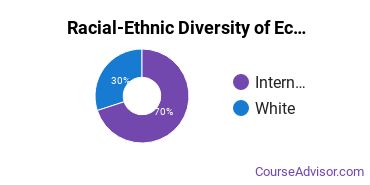Economics at Drexel University
Drexel is located in Philadelphia, Pennsylvania and has a total student population of 23,589.
Want to know more about the career opportunities in this field? Check out the Careers in Economics section at the bottom of this page.
Drexel Economics Degrees Available
- Bachelor’s Degree in Economics
- Master’s Degree in Economics
Drexel Economics Rankings
The economics major at Drexel is not ranked on College Factual’s Best Colleges and Universities for Economics. This could be for a number of reasons, such as not having enough data on the major or school to make an accurate assessment of its quality.
There were 1 student who received their doctoral degrees in economics. This is the #115 most popular school in the United States for this category of students.
Economics Student Demographics at Drexel
Take a look at the following statistics related to the make-up of the economics majors at Drexel University.
Drexel Economics Bachelor’s Program

The following table and chart show the race/ethnicity for students who recently graduated from Drexel University with a bachelor's in economics.

| Race/Ethnicity | Number of Students |
|---|---|
| Asian | 9 |
| Black or African American | 1 |
| Hispanic or Latino | 2 |
| White | 23 |
| International Students | 15 |
| Other Races/Ethnicities | 3 |
Drexel Economics Master’s Program

Of the students who received a economics master's degree from Drexel, 73% were white. This is above average for this degree on the natiowide level.
The following table and chart show the race/ethnicity for students who recently graduated from Drexel University with a master's in economics.

| Race/Ethnicity | Number of Students |
|---|---|
| Asian | 0 |
| Black or African American | 0 |
| Hispanic or Latino | 1 |
| White | 8 |
| International Students | 2 |
| Other Races/Ethnicities | 0 |
Concentrations Within Economics
Economics majors may want to concentrate their studies in one of these areas. The completion numbers here include all graduates who receive any type of degree in this field from Drexel University. Some of these focus areas may not be available for your degree level.
| Concentration | Annual Degrees Awarded |
|---|---|
| Econometrics & Quantitative Economics | 42 |
| General Economics | 8 |
Related Majors
Careers That Economics Grads May Go Into
A degree in economics can lead to the following careers. Since job numbers and average salaries can vary by geographic location, we have only included the numbers for PA, the home state for Drexel University.
| Occupation | Jobs in PA | Average Salary in PA |
|---|---|---|
| Market Research Analysts and Marketing Specialists | 26,750 | $68,630 |
| Managers | 11,060 | $126,290 |
| Economics Professors | 710 | $131,060 |
| Economists | 610 | $87,630 |
| Survey Researchers | 510 | $60,810 |
References
*The racial-ethnic minorities count is calculated by taking the total number of students and subtracting white students, international students, and students whose race/ethnicity was unknown. This number is then divided by the total number of students at the school to obtain the racial-ethnic minorities percentage.
- College Factual
- National Center for Education Statistics
- O*NET Online
- Image Credit: By Daderot under License
More about our data sources and methodologies.
